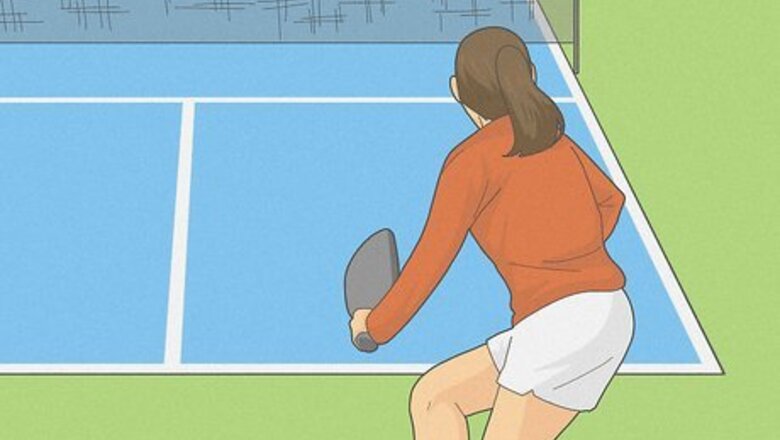
views
- Score in pickleball when you are serving and your opponent commits a fault. You can only score while serving.
- Your opponent gets the serve if you commit a fault (in doubles, 2 faults) while serving, but does not score a point.
- Play until one player or team has at least 11 points and is at least 2 points ahead of the other team.
Pickleball Scoring Basics
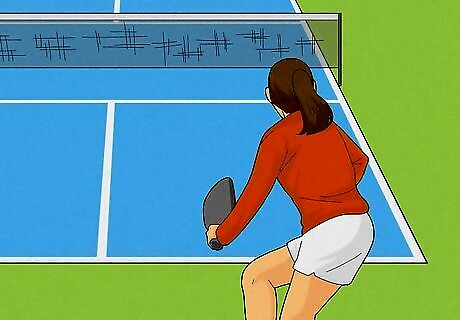
Start the game with a serve from the right side. The right side of the court is also referred to as the "even" side. Since you start a pickleball game with zero points, which is an even number, you start on the right side. In a singles game, both players would be on their right side, since you serve diagonally into your opponent's service area.

Score a point if you win a rally while serving. If the receiving team or player commits a fault, the serving team or player wins a point. You can only score a point while you are serving. The receiving team never scores. Faults the receiving team can commit include: The initial return of the serve is hit before the ball bounces once The ball is hit into the net or out of bounds The ball hits a player or the player's clothing A paddle, player, or player's clothing hits the net while the ball is in play
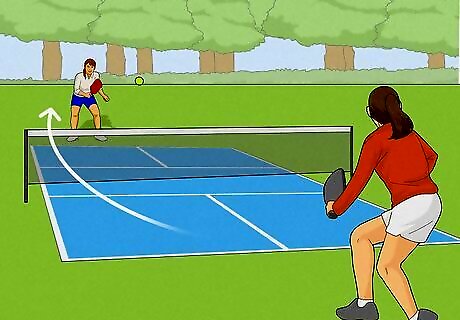
Change servers if the serving team commits a fault. In doubles, if the first server commits a fault, the second server gets a chance to serve. In singles or if the second server faults, the player or team is considered "side-out" and the serve passes to the opposing player or team. Note that the receiving team does not receive a point if the serving team commits a fault. Faults the serving team can commit include: The serve doesn't hit the opponent's diagonal service area The server strikes the ball with a foot inside the baseline The server or serving team hits the initial service return before the ball bounces once The ball is hit into the net or out of bounds The ball hits a player or the player's clothing A paddle, player, or player's clothing hits the net while the ball is in play
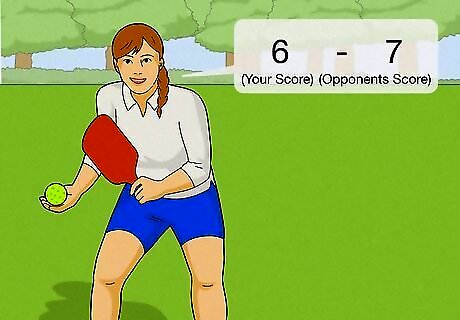
Call out the score before every serve. Calling out the score before every serve helps every player keep track of the score. Since you can only serve one point at a time and only the serving team can score, there's only one part of the score that will change. The server's score is always first, followed by the receiver's score. This means the position of the numbers can change even when the score hasn't. For example, if you've scored 6 points and your opponent has scored 7 points, you'd call out "6 7" before you served the ball. Assume you commit a fault and the service switches to your opponent. Your opponent calls the score as "7 6" before they serve the ball. Even though the score hasn't changed, the positions of the numbers have changed because now your opponent is the server.
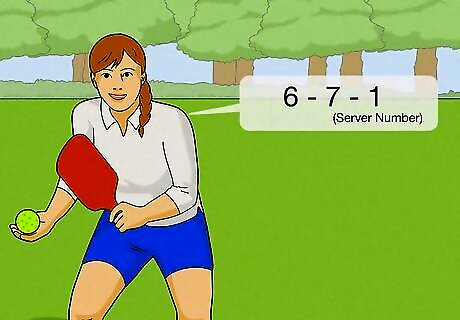
Add the server number to the end of the score in doubles. If you're playing a doubles game, the score consists of 3 numbers: the server's score, the receiver's score, and the server number. The server number will always be 1 or 2. For example, say you're serving in a doubles game and you're the first server. Your team has scored 6 points and your opponent has scored 7 points. You would call out "6 7 1" before you served the ball. In tournament play, it's common to pick one teammate to call the score. That teammate then calls the score when their team is serving, regardless of whether they're the one serving.
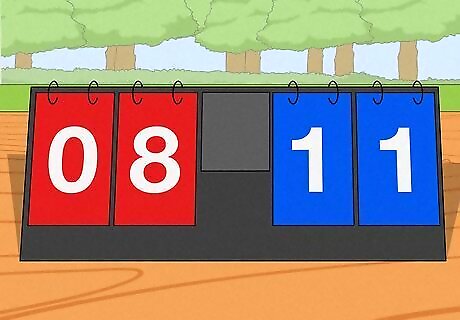
Play until one player or team gets 11 points or wins by a margin of 2. You normally play pickleball to 11 points, but if the player or team with 11 points doesn't have at least a 2-point margin of victory, the game goes on. Play continues until one player or team scores with a 2-point margin over their opponent. In tournaments, games might be played to 15 or 21—especially doubles games. Tournaments also typically consist of matches. Win a match by winning at least 2 out of 3 games ("best of three" style).
Scoring a Doubles Game

Call out 0 0 2 to start the game if you have first serve. On the first serve of the game, the server position is always "2" because the team that serves first only gets one chance to serve here. This helps balance out the innate advantage of getting to serve first. After the first serve of the game, your team will have 2 chances every time you get the serve. You won't keep the same server number the whole game—it will change as the game progresses. After the first serve, the player on the right when your service starts will be server 1. Some people will just say "start" because everybody knows the score at this point, and there's nothing wrong with that if you're more comfortable with it.

Start every new service from the right side of the court. This rule applies to the first serve of the game as well as each team's first serve after a side-out. If the serving team scores, the server switches sides and serves from the left side of the court. If the serving team commits a fault, service switches to the left side of the court, but the players don't switch positions.
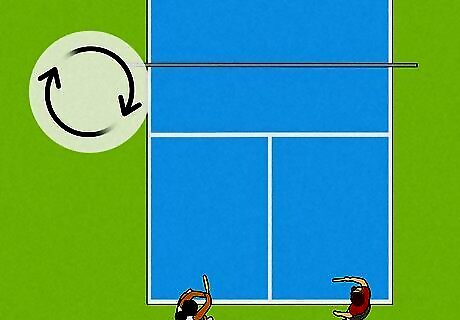
Score points as the serving team until you commit a fault. Switch sides with your teammate every time your team scores. When your team commits a fault, pass service to your teammate. Your teammate then has the opportunity to serve until your team commits another fault. Remember that you and your teammate will switch positions after every point you score. For example, if your team commits a fault while you're serving from the left as the first server, your teammate would take the serve as the second server and serve from the right. Note that no one switched places because you didn't score a point. If your opponent commits a fault while your teammate is serving from the right, you win a point. You and your teammate switch places and your teammate now serves from the left.
Scoring a Singles Game
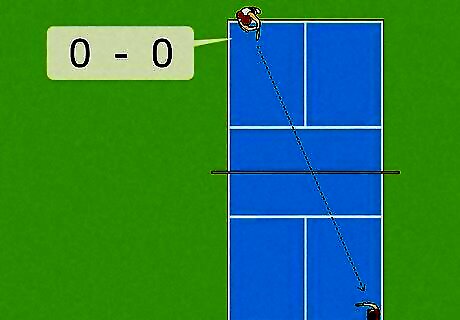
Call out 0 0 at the first serve of the game. If it's the first serve of the game, the score is easy—no one's scored a point yet, so you're tied at 0. Some people just say "start" here instead of calling out the score, and that's fine too. Since "0" is an even number, it also makes sense that the first serve of a singles game comes from the right side of the court.

Score points only while you're serving. As the server in a singles game, you have the chance to win a point every time the receiver commits a fault. Each time you score a point, switch to the other side of the court before you serve. Your opponent will switch sides as well because they'll always return your serve diagonal from you. For example, if your opponent commits a fault after you've served the first serve of the game, you now have 1 point. You switch to the left side of the court since 1 is an odd number and serve again. Now it's the second serve of the game. If your opponent commits a fault, you'd have 2 points as the server and would switch to the right/even side. On the other hand, if you committed a fault, you'd be side-out and your opponent would start their serve from the right/even side.

Give up the serve to the other player if you commit a fault. Neither you nor your opponent changes positions here because no one has won a point. Your opponent doesn't win a point when you commit a fault, they simply gain the serve. To continue with the previous example, say it's now the second serve of the (1 0) game and you're serving from the left because your score is odd. You commit a fault, which means you're side-out and your opponent gets the serve. They serve from the right and announce the score as "0 1."

Use the side of the court to help keep track of the score. As long as you make it a habit to switch sides every time you score, this can help you remember the score—even if your game seems to drag on forever. If you're serving from the right side of the court, your score is even. If you're serving from the left side of the court, your score is odd. A gameplay example can help you see how this works. When you start the game, you serve from the right because you have zero points, which is even. Your opponent fails to return your serve and you earn one point. You move to the left because your score is now odd.















Comments
0 comment